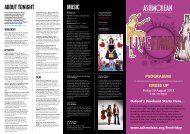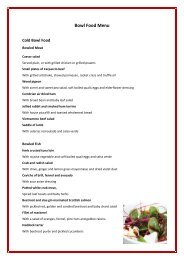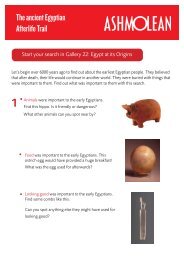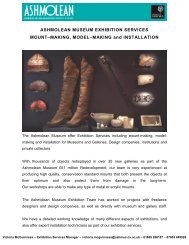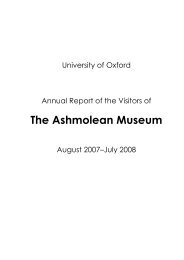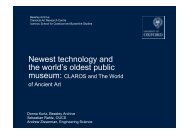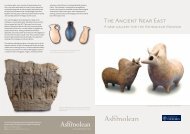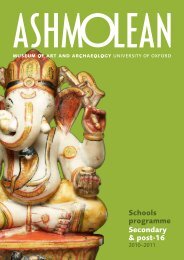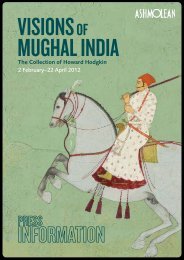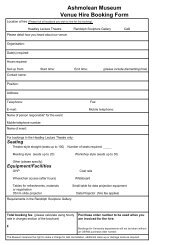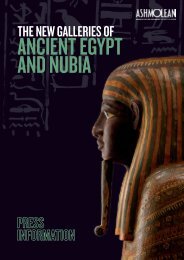The Bronze Age: Canaan - The Ashmolean Museum
The Bronze Age: Canaan - The Ashmolean Museum
The Bronze Age: Canaan - The Ashmolean Museum
Create successful ePaper yourself
Turn your PDF publications into a flip-book with our unique Google optimized e-Paper software.
ANCIENT NEAR EASTERN TERRACOTTAS<br />
published from levels XVIII to IV at Megiddo (Loud 1948, pl. 244–6) illustrative of the standard range;<br />
but with few illuminating details about their associations and contexts. As in prehistory many quadrupeds<br />
are too schematic to allow for close identification, whilst levels of damage at times preclude it even with<br />
the more realistic examples. <strong>The</strong>re is enough scattered evidence to suggest that these images, as in the Iron<br />
<strong>Age</strong>, may well have been more common than the plaques depicting women.<br />
(e)<br />
<strong>The</strong> <strong>Canaan</strong>ite Legacy<br />
This is fully considered in the following section on terracottas of the Southern Levant in the Iron <strong>Age</strong>,<br />
after 1200 B.C. In their wide-ranging summary of the contemporary imagery Keel and Uehlinger (1998,<br />
154) have remarked of the varied use of terracotta, particularly for cult-stands and other related objects<br />
in the early Iron <strong>Age</strong>, that “we see a fundamentally ‘conservative’ approach when terracotta serves as the<br />
medium. Various older ways to depict the subject matter are still visible on plaques and cult stands long<br />
after such styles went out of fashion for those who used other media... This ‘conservative’ tendency makes<br />
sense sociologically, since most of these terracottas are associated with ‘private’ or family piety”.<br />
Minimal variation of form and imagery is the most striking aspect of Late <strong>Bronze</strong> <strong>Age</strong> <strong>Canaan</strong>ite<br />
terracottas in human form, whose iconography was primarily, if not exclusively, of significance to women.<br />
In pottery manufacture there tends to be least variation of forms when production is most centralized and<br />
vice versa. By this criterion <strong>Canaan</strong>ite anthropomorphic figurine production was highly standardized and<br />
centralized, at least in so far as control over its imagery was concerned, extending an official iconography<br />
into the households and work places of <strong>Canaan</strong> and from time to time into the graves of <strong>Canaan</strong>ites.<br />
This imagery would appear to have been focussed on one major goddess, primarily of interest to women;<br />
but, in considering these images, the much later words of Jeremiah (44: 19) should be held in mind: “<strong>The</strong><br />
women added, ‘When we offer incense to the “Queen of Heaven” and pour libations in her honour, do<br />
you think we make cakes for her with her features on them, and pour libations to her, without our<br />
husbands’ knowledge” <strong>The</strong>re is little difference between mouldmade clay plaques and moulded dough<br />
images, save that the latter are perishable. <strong>The</strong> “Queen of Heaven” is not certainly identified, but belongs<br />
to the closely related group of major goddesses including Assyro-Babylonian Ishtar and West Semitic<br />
Astarte and Asherah (cf. Hadley 2000, 59).<br />
-188-




